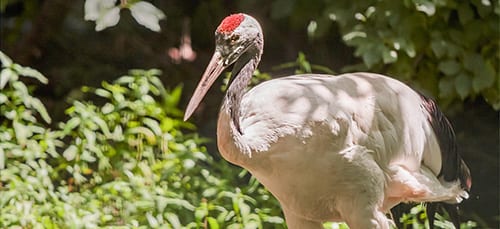WHERE THEY HANG OUT
At the zoo: Cinereous vultures can be found in two locations at the zoo at the Nuture Trail and the Pachyderm Habitat.
In the wild: scrub, steppe and open grassland across Europe and Asia
Favorite Foods
At the zoo: rats, mice, carcasses and specially formulated diet for birds of prey
In the wild: carrion and may take live prey such as insects, snakes and lizards
Social Life
Primarily solitary and monogamous, these birds can sometimes be found feeding or nesting in small groups.
About Drogo
Aegypius monachus
Introducing our feathered friend, Drogo. He is a cinereous vulture (Aegypius monachus). He came to Denver Zoo from Toledo Zoo in May of 2014 when he was about 1 year old. This species is from Europe and Asia. Denver Zoo has a conservation focal area in Mongolia) and has been working there since 1996. Cinereous vultures come to Mongolia in large numbers because of the great breeding habitat and this provides a great opportunity to study them. In Mongolia the local people on the conservation site called them Tas or “vulture” in Mongolian. Mongolia is home to several endangered and threatened species like the cinereous vulture. Denver Zoo’s conservation work helped create Ikh Nart Nature Reserve to protect wildlife habitat and develop alternative income sources for local people.
Drogo is still young and his personality matches his age. He loves to investigate everything his keepers give him and even things they do not want him to have. And he loves biting and trying to take things away from them. To some people this looks a little aggressive since he is a very large bird, but he is just curious. He is a very good eater and his favorite food is “food”. He loves to eat ground meat, guinea pigs, rats, and bones (for gnawing on). You can tell which bird is Drogo by his cute dark head which will lighten up as he ages and his lack of a wing tag which only his mate has.
Cinereous vultures are near threatened in the wild according to IUCN Red list and their population is decreasing. The two main threats to the species are direct mortality caused by humans (either accidentally or deliberately) and decreasing availability of food. Similar threats affect many other vulture species all over the world. The main food supply of vultures is carrion from medium to large mammal species. As these mammal species, decline so do the vultures that depend on them. Poison is another threat that can be accidental or deliberate. Ranchers leave out poisoned bait to exterminate predators. Hunters and poachers leave parts of a carcass they shot with lead gunshot which the vultures then eat and are poisoned. Occasionally vultures are shot for either their feathers or by poachers who fear the presense of the vultures will bring attention to their illegal hunting.
You can visit our cinereous vultures in two different locations. There is a breeding pair on the Nurture Trail by Lorikeet Adventure. Drogo and his mate, Aztai, are residents in the outside yard by the black rhinos and hippos. He is very cold hearty so he can be seen year-round in the outside exhibit.

